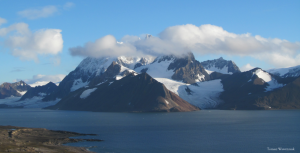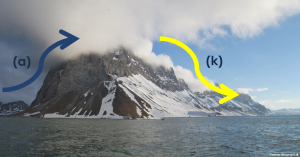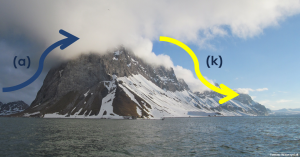Chmury orograficzne
Powstają w wyniku przepływu wilgotnych mas powietrza nad obszarami o urozmaiconej rzeźbie terenu (np. grzbietów górskich).
Powietrze wznosi i schładza się (to tzw. wiatry anabatyczne-na zdjęciu oznaczone {a), czyli wznoszące się po stoku, para wodna kondensuje, powstaje chmura i zwykle pojawiają się opady. Po przekroczeniu grzbietu, pojawia się wiatr, który powstaje gdy gęste, suche powietrze spływa po stoku pod wpływem grawitacji (czyli tzw. wiatry katabatyczne – na zdjęciu oznaczone (k).
Przykładami chmur orograficznych są:
- wał fenowy
- chmura sztandarowa
- czapa chmurowa
- chmury falowe
- chmury grzbietowe
- chmury stokowe
- Chmury orograficzne nad masywem Hornsund, Spitsbergen
- Wał fenowy nad pasmem Sofiekammen, Hornsund, Spitsbergen





 This project (EDU-ARCTIC) has received funding from the European Union’s Horizon 2020 research and innovation programme under grant agreement No 710240. The content of the website is the sole responsibility of the Consortium and it does not represent the opinion of the European Commission, and the Commission is not responsible for any use that might be made of information contained.
This project (EDU-ARCTIC) has received funding from the European Union’s Horizon 2020 research and innovation programme under grant agreement No 710240. The content of the website is the sole responsibility of the Consortium and it does not represent the opinion of the European Commission, and the Commission is not responsible for any use that might be made of information contained.